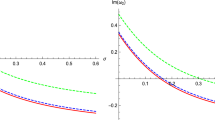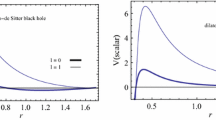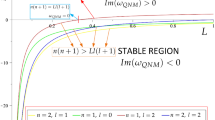Abstract
The rotating linear dilaton black hole is an asymptotically non-flat solution to Einstein–Maxwell-Dilaton–Axion gravity theory due to the existence of non-trivial matter fields. We have analytically studied the wave equation of scalar field in this background and shown that the radial wave equation can be solved in terms of hypergeometric function. By determining the ingoing and the outgoing fluxes at the asymptotic infinity, we have found the analytical expressions for reflection coefficient and greybody factor for certain scalar modes. We further apply the method of Damour–Ruffini to investigate the Hawking radiation of the rotating linear dilaton black hole, which shows that the Hawking temperature is proportional to the surface gravity of event horizon. Finally, the quasinormal modes of scalar field perturbation are also presented, which shows that the rotating linear dilation black hole is unstable for certain modes apart from the superradiant modes.


Similar content being viewed by others
References
S.W. Hawking, Commun. Math. Phys. 43, 199 (1975)
W.G. Unruh, Phys. Rev. D 14, 3251 (1976)
T. Damour, R. Ruffini, Phys. Rev. D 14, 332 (1976)
S. Christensen, S. Fulling, Phys. Rev. D 15, 2088 (1977)
M.K. Parikh, F. Wilczek, Phys. Rev. Lett. 85, 5042 (2000)
S.P. Robinson, F. Wilczek, Phys. Rev. Lett. 95, 011303 (2005)
S. Iso, H. Umetsu, F. Wilczek, Phys. Rev. Lett. 96, 151302 (2006)
D.N. Page, Phys. Rev. D 13, 198 (1976)
J. Maldacena, A. Strominger, Phys. Rev. D 55, 861 (1997)
S.S. Gubser, I.R. Klebanov, Phys. Rev. Lett. 77, 4491 (1996)
I.R. Klebanov, M. Krasnitz, Phys. Rev. D 55, 3250 (1997)
I.R. Klebanov, S.D. Mathur, Nucl. Phys. B 500, 115 (1997)
M. Cvetic, F. Larsen, Phys. Rev. D 56, 4994 (1997)
M. Cvetic, F. Larsen, Nucl. Phys. B 506, 107 (1997)
M. Cvetic, F. Larsen, Phys. Rev. D 57, 6297 (1998)
H.W. Lee, Y.S. Myung, Phys. Rev. D 58, 104013 (1998)
E. Jung, S. Kim, D.K. Park, J. High Energy Phys. 0409, 005 (2004)
S. Fernando, Gen. Relativ. Gravit. 37, 461 (2005)
J. Grain, A. Barrau, P. Kanti, Phys. Rev. D 72, 104016 (2005)
S. Creek, O. Efthimiou, P. Kanti, K. Tamvakis, Phys. Rev. D 75, 084043 (2007)
S. Creek, O. Efthimiou, P. Kanti, K. Tamvakis, Phys. Rev. D 76, 104013 (2007)
W. Kim, J.J. Oh, J. Korean Phys. Soc. 52, 986 (2008)
S. Chen, B. Wang, R. Su, W.-Y. Hwang, J. High Energy Phys. 0803, 019 (2008)
S. Chen, B. Wang, R. Su, Phys. Rev. D 77, 024039 (2008)
S. Chen, J. Jing, arXiv:0809.3164
S. Chen, B. Wang, J. Jing, Phys. Rev. D 78, 064030 (2008)
S. Chen, B. Wang, R. Su, Phys. Rev. D 77, 124011 (2008)
H. Ishihara, J. Soda, Phys. Rev. D 76, 064022 (2007)
L.C.B. Crispino, A. Higuchi, G.E.A. Matsas, Phys. Rev. D 82, 124038 (2010)
Y. Decanini, G. Esposito-Farese, A. Folacci, Phys. Rev. D 83, 044032 (2011)
P. Gonzalez, E. Papantonopoulos, J. Saavedra, J. High Energy Phys. 1008, 050 (2010)
P. Gonzalez, C. Campuzano, E. Rojas, J. Saavedra, arXiv:1003.2753 [gr-qc]
P. Gonzalez, J. Saavedra, arXiv:1104.4795 [gr-qc]
C. Ding, S. Chen, J. Jing, Phys. Rev. D 82, 024031 (2010)
C. Ding, C. Liu, J. Jing, S. Chen, J. High Energy Phys. 1011, 146 (2010)
V. Cardoso, M. Cavaglia, L. Gualtieri, Phys. Rev. Lett. 96, 071301 (2006)
V. Cardoso, M. Cavaglia, L. Gualtieri, J. High Energy Phys. 0602, 021 (2006)
S.R. Das, G. Gibbons, S.D. Mathur, Phys. Rev. Lett. 78, 417 (1997)
K. Ghoroku, A.L. Larsen, Phys. Lett. B 328, 28 (1994)
M. Natsuume, N. Sakai, M. Sato, Mod. Phys. Lett. A 11, 1467 (1996)
D. Birmingham, I. Sachs, S. Sen, Phys. Lett. B 413, 281 (1997)
J.J. Oh, W. Kim, J. High Energy Phys. 0901, 067 (2009)
J.J. Oh, W. Kim, Eur. Phys. J. C 65, 275 (2010)
H.-C. Kao, W.-Y. Wen, J. High Energy Phys. 0909, 102 (2009)
B. Chen, B. Ning, Phys. Rev. D 82, 124027 (2010)
R. Li, M.-F. Li, J.-R. Ren, Eur. Phys. J. C 71, 1566 (2011)
R. Li, J.-R. Ren, Phys. Rev. D 83, 064024 (2011)
G. Clement, J.C. Fabris, G.T. Marques, Phys. Lett. B 651, 54 (2007)
S.H. Mazharimousavi, I. Sakalli, M. Halilsoy, Phys. Lett. B 672, 177 (2009)
P.I. Slavov, S.S. Yazadjiev, Phys. Rev. D 86, 084042 (2012)
G. Clement, D. Galtsov, C. Leygnac, Phys. Rev. D 67, 024012 (2003)
J.D. Brown, J.W. York, Phys. Rev. D 47, 1407 (1993)
R. Li, J.-R. Ren, J. High Energy Phys. 1009, 039 (2010)
P.-J. Mao, R. Li, L.-Y. Jia, J.-R. Ren, Eur. Phys. J. C 71, 1527 (2011)
J.-R. Ren, P.-J. Mao, R. Li, L.-Y. Jia, Class. Quantum Gravity 27, 165016 (2010)
Acknowledgements
I would like to thank Pu-Jian Mao and Ming-Fan Li for reading the manuscript and useful comments. This work was supported by NSFC, China (Grants No. 11147145 and No. 11205048).
Author information
Authors and Affiliations
Corresponding author
Appendix: Greybody factor for the modes ωr 0<1/2
Appendix: Greybody factor for the modes ωr 0<1/2
In the present case, the parameter β is real which makes the splitting of the ingoing and the outgoing flux at the asymptotic infinity a non-trivial task. The physical origin is that the rotating linear dilaton black hole is not asymptotically flat.
By inserting the asymptotic solution (28) into the definition of flux, one can obtain the flux at the asymptotic infinity

We can define the ingoing and the outgoing wave coefficients D in and D out by splitting up the coefficients D 1 and D 2 as D 1=D in+D out and D 2=i(D in−D out). Then, the asymptotic flux can be written in the form of

The greybody factor can be calculated by

where \(\mathcal{D}\) is given by the following expression:

One can analyse the properties of greybody factor of scalar field in rotating linear dilaton black hole background in the low energy and low angular momentum limits. This aspect is out of scope of the present paper.
Rights and permissions
About this article
Cite this article
Li, R. Analytical study of greybody factor and quasinormal modes for the scalar field in rotating linear dilaton black hole. Eur. Phys. J. C 73, 2296 (2013). https://doi.org/10.1140/epjc/s10052-013-2296-y
Received:
Revised:
Published:
DOI: https://doi.org/10.1140/epjc/s10052-013-2296-y




